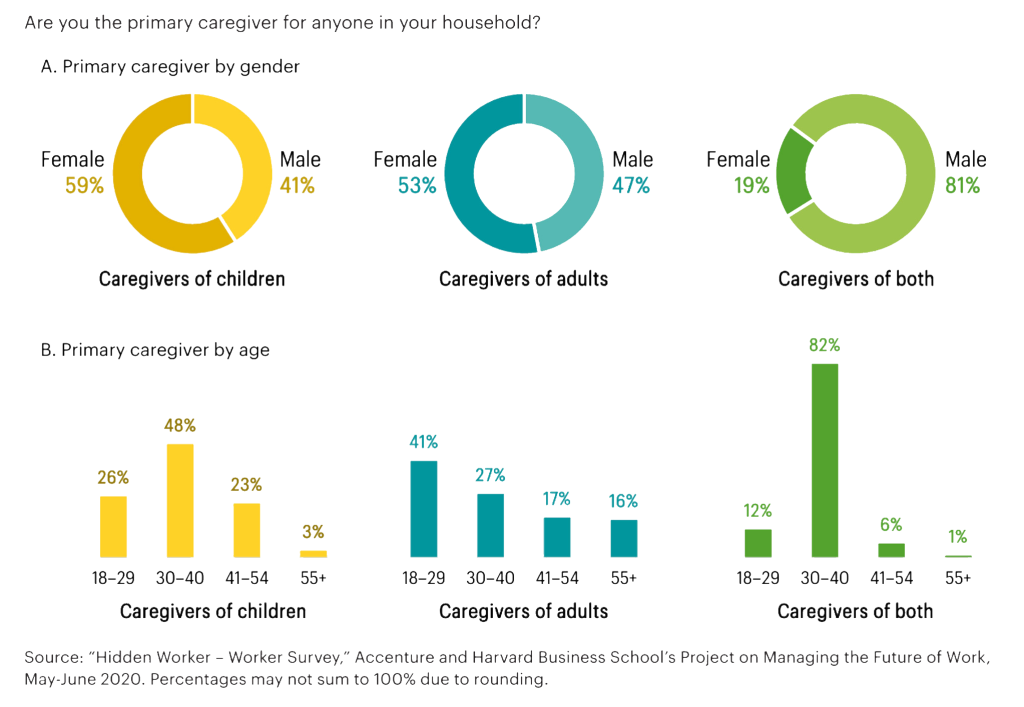
Joseph Fuller co-chairs the Managing the Future of Work project at Harvard Business School.
Harvard file photo
Millions of workers are also juggling caregiving. Employers need to rethink.
Business School report finds rigid hiring policies, work rules, scheduling hurt employees but also productivity, retention, bottom line
Millions of Americans, from hourly retail staffers to corporate vice presidents, wrestle with the demands of work while parenting young children, caring for a sick spouse or aging parent — or both.
That juggling act is made even tougher by rigid practices and rules set by employers, such as inflexible or unpredictable work schedules, and employers’ failure to grasp how employees are struggling and to provide them with support, according to a new Harvard Business School report.
That disregard harms both workers and companies. Care-related issues are the single most common reason employees leave the workforce. Companies also pay a price, both directly and indirectly, often in waysthey don’t fully understand, the report found.
The Gazette spoke with its author Joseph B. Fuller ’79, M.B.A. ’81, professor of management practice and co-chair of the Managing the Future of Work project at HBS, about the problem and what companies can do. Interview has been edited for clarity and length.
There are 50 to 60 million caregivers in the nation. They make up the largest portion of a cohort you study known as “hidden workers” — those who want a job or more hours but are thwarted by employer policies. Who is in this group and why do they leave the workforce?
They are people who have some significant care obligations within their household. Those range from things that would strike people as very ordinary — a two-parent household with kids — or it could be something much more exotic — they have a chronically ill child or spouse. An apogee group is what we call the “sandwich generation,” where they’re caring for dependent children, from a newborn to a teenager, but they’re also caring for one or more seniors — a parent, an in-law.
Well over 50 percent of workers report they have some caregiving obligation. The question becomes: Do the terms and conditions of their employment and the nature of that obligation mesh? A lot of traditional expectations of employers, but also coworkers and even customers, don’t always jibe with the cadence of care.
We can see this in things like work schedule. If I have a child with a chronic condition, anything from severe asthma to a behavioral issue, stuff happens. And if I have to go see the principal of the school tomorrow because of a disciplinary problem or it’s a bad air-quality day and my child really shouldn’t be outdoors, I’m going to keep them home from school. As a normal working adult, I don’t have money to hire a service, so I’m going to miss a day of work.
Fifty percent of women who have left the workforce and say they would have preferred to remain working left because they could not reconcile the obligations of the career path they were on with caring for kids.
Primary caregiver by gender and age

Caregiving, along with higher education and healthcare delivery, has among the highest real-dollar increase in cost in the last 10 to 15 years. Childcare is more expensive than it’s ever been in real dollars. If you’re paying $1,200, $1,300 a month for full-day childcare, for an average American job, that would be equal to the average after-tax, discretionary income that a worker is left with at the end of the month. So, economics underlies many people’s considerations. But it’s also a combination of career considerations and the specific caregiving needs of the family.
You found that hiring processes used by employers have contributed to the difficulties caregivers face when trying to return to work after some circumstance forces them to leave the workplace for a time. Why is that?
Unfortunately, several things start happening if your work history gets interrupted. The first is something that virtually every employer uses to assess candidates called the continuity of employment filter, which is used in an AI-powered tool called an applicant tracking system. It asks an employer: If someone has a gap in their work history, how should I treat that? If there’s a gap of more than six months, 50 percent of employers will drop a person from the candidate pool.
How does the struggle to manage work and caregiving typically manifest on the job? Do most employers even realize some workers are having a hard time?
First of all, employees in most companies only go to their boss or to their company to discuss a caregiving issue as a last resort. Their concern is: If I bring this up, I’m certainly not going to be a candidate for promotion. It’s going to affect my performance evaluation. They fear they’ll be viewed as less committed, that they’re going to be suspect.
The biggest two effects of having caregiving responsibilities that are hard to reconcile with your job are absenteeism and presenteeism. Either you’ll miss work, or you’ll be so distracted while you’re at work you won’t get much done.
For a lot of frontline lower-wage jobs, companies have a rule that if someone is late to work three times in a month or has an un-preplanned absence three times in a quarter, by rule you’re just fired. And that’s completely understandable. They’re running complicated operations; they can’t let every store manager make their own decisions, not only because it would be chaos, but also because if somebody in Topeka is getting fired, but a person who did the same thing in Toledo is being kept because the store managers made different decisions and it all ends up in court, the company loses.
And companies, especially human resources functions, hate administering exceptions. Walmart employs a million people. If all of a sudden everything is customized, they’d be out of business in 6 months.
One thing my early research showed is that caregiving concerns are endemic. They affect roughly 80 percent of the workforce some of the time, most of the time, or all of the time. But the way working relationships have been structured by employers for a century rests on propositions like “I’m paying you and providing a decent place to work. I don’t want to intrude on your life, and I don’t want to hear about it. I don’t want to talk about it.”
Besides concerns about fairness, administrative logistics, and lost productivity, there are costs for failing to address the caregiving needs of employees, costs many companies don’t realize they’re paying. What are some of those?
First, there’s a very substantial cost of replacing a worker. It doesn’t matter if they’re fired, or they quit. Even for low-wage workers, the cost is between 25 percent and 35 percent of annual compensation. That’s a good proxy for how much it’s going to cost to replace that worker.
Second, people who have some tenure with the employer have lots of knowledge based on that experience, which makes them more productive. Say they join your company at age 24 or 25 and then after four or five years, they decide to start a family. They’ve got five years of work experience; they have a network inside the company; they may know customers; they know how you do things. But they conclude they can’t stay given the requirements of the job.
“There’s a very substantial cost of replacing a worker. Even for low-wage workers, the cost is between 25 percent and 35 percent of annual compensation.”
Unless employers assist them so they can stay in the job, they give up a productive worker. Their replacement is an unknown quantity. Employers constantly make speculative bets on new employees based on pieces of paper and a couple of interviews to replace a worker the company has a huge amount of data on from personnel files, performance evaluations, etc.
When they replace the worker who leaves because of caregiving conflicts, they incur the direct costs, but they also absorb indirect costs, what we call “tacit knowledge” — how we do things around here. And say that worker is on a team and they’re the glue on that team. Another team member has been thinking about quitting, too. We know from psychological research that person will feel psychological permission to quit if another worker quits.
What my research shows is the more senior you are, and the more money you make, the more likely you are to leave a job because of a caregiving obligation. Employers are always surprised by that. They assume a worker is more likely to leave if they’re low-paid.
A worker in the top quartile of compensation is more likely to leave a job because of a caregiving conflict by a factor of two than a bottom-quartile worker. And that 25 percent to 35 percent cost of replacing a worker goes to 100 percent or more of annual compensation if you’re talking about a top-quartile worker — middle management, upper-middle management, all the way to the executive ranks.
All those things add up. Unfortunately, employers historically aren’t very good at connecting those dots. They don’t understand their own economics.
Why aren’t they better at seeing the full picture of these costs?
Unfortunately, the lack of connection between managers and supervisors of workers, and their lived experience, and the human resources function is really quite surprising. HR, particularly in big companies, just tends to see data. They’re not talking to supervisors who say, “My best workers are leaving regularly and here’s why.” A lot of companies don’t do exit interviews, so they don’t connect data about why somebody leaves in performance reviews. They don’t say, “Is there anything that’s causing you to think about leaving the company?”
What should employers do to remedy this situation?
The first is to realize there’s a big pool of talent out there that’s been marginalized because of caregiving responsibilities.
Employers should review how they search for talent and what conditions they’re putting on applicants in the applicant tracking system and adjust them to include more candidates. There’s this big pool of workers that is being structurally obliged to end up in part-time, low-wage work because of these “disqualifying” factors. I’m not going to say those standards are arbitrary, but they contribute to an artificial shortage of qualified candidates that employers complain about despite policies creating that shortage.
A second is, understand that all your employees are past, current, and future caregivers and that their circumstances will change. Their life path affects their productivity and their propensity to quit or to behave in a way that causes you to fire them.
Understand the care demographics of your workforce. Make their caregiving lives outside work something that’s discussable with their supervisor. There’s a tremendous return on loyalty and engagement from workers who hear from their supervisors.
Do exit interviews, add to your performance review questions like “Have you thought about leaving? What would cause you to do that?” Find out what’s driving absentees and resignations? Look at your own data.
Just invest in having a more sophisticated understanding of your own economics. Because if you do, you’ll make better decisions.
Get the best of the Gazette delivered to your inbox
By subscribing to this newsletter you’re agreeing to our privacy policy




